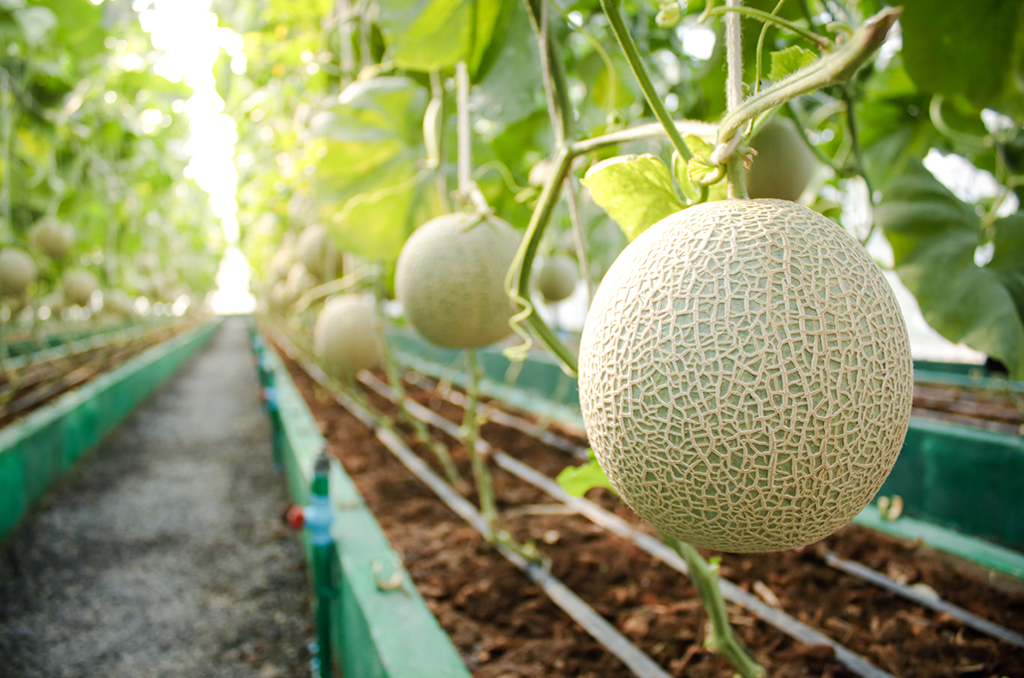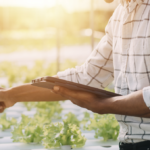
Introducing the Future of Agriculture: Climate-Resilient Fruits and Vegetables
- foodfightadmin
- September 26, 2023
- Uncategorized
- rsc pages, rscl
- 0 Comments
Meet the Climate-Defying Fruits and Vegetables in Your Future
The world of plant breeding, traditionally a realm of patience and precision, is now faced with a pressing challenge: adapting to an increasingly erratic climate. This urgency has become more apparent as recent climatic events, like floods in California, left a significant portion of the state’s table grapes to rot on the vine. Meanwhile, excessive sunlight is scorching apple crops, and unexpected pests are invading lettuce fields.
The task at hand for plant breeders is formidable – developing new crop varieties capable of withstanding these environmental stresses. This endeavor is a long-term one, with potential solutions emerging from diverse research areas, ranging from cutting-edge molecular gene-editing technology to the exploration of global seed collections that have been preserved for centuries.
However, there’s a crucial criterion that these new breeds must meet: they need to be palatable. “You can use these technical solves to find climate solutions, but they won’t be useful if it’s not what people want to eat,” explained Michael Kantar, an associate professor at the University of Hawai’i at Manoa, who specializes in studying the wild relatives of current crops.
Already, some of these innovative varieties have made their way to grocery stores, while others are still in the conceptual phase. Here’s a glimpse into some of the most promising new fruits and vegetables poised to make a mark in our changing climate.
Cherries That Can Take the Heat
In the ever-evolving field of agriculture, a significant breakthrough has been made in cherry cultivation, particularly in adapting to warmer climates. Traditionally, cherry trees require a significant amount of “chill hours” — periods with temperatures between 32 and 45 degrees — spanning at least a month during winter. This chilling period is crucial for ensuring proper blossoming and fruit production. However, with winters becoming increasingly warmer, some regions are struggling to provide these essential chill hours, leading to erratic blooming and, in some cases, complete crop failure.
Addressing this challenge, International Fruit Genetics, which was recently acquired by Bloom Fresh International, has developed the heart-shaped Cheery Cupid cherry. Notably, the scientists involved in this innovation are also credited with breeding the popular cotton candy-flavored grapes. The Cheery Cupid cherries are distinguished by their reduced need for cold weather, requiring only about a third of the typical chill hours.
Chris Owens, the lead plant breeder at the company, elaborates on the dual objectives of this breeding effort: “What we are trying to do is make them more tolerant in the summer to withstand this ridiculous heat, but they also need to survive a hotter winter.” This development marks a significant stride in adapting fruit cultivation to the changing climate, ensuring cherry production can continue even in warmer conditions.
Cauliflower With Sunscreen
In the agricultural sector, a noteworthy development has been made in cauliflower cultivation, addressing a key challenge faced by farmers. The maturity of a cauliflower is indicated when its green leaves open, revealing the white head known as the curd. However, this curd is highly sensitive to sunlight; excessive exposure can cause it to turn spotty and beige, rendering it unsuitable for sale in grocery stores.
Traditionally, to protect the cauliflower from sun damage, farmers manually fold the leaves back over the curd approximately two weeks before harvesting. This process is both costly and labor-intensive. In response to this challenge, plant breeders have developed the Destinica true-white cauliflower, a variety that is now a common sight in supermarkets. This innovative cauliflower variety is resistant to sunburn, thereby eliminating the need for manual leaf folding. Additionally, it is more soil-friendly, as it reduces the need for workers to walk through the fields.
The Destinica is part of a series of climate-friendly cauliflower varieties developed by Syngenta Vegetable Seeds, a division of the global agricultural company Syngenta, based in Switzerland. Alongside the Destinica, farmers are also cultivating Syngenta’s weatherproof white cabbage, which demands less nitrogen fertilizer and can withstand prolonged dry spells. This variety of cabbage grows slightly higher off the ground, facilitating easier harvesting. These advancements represent significant strides in creating crop varieties that are more resilient to changing climatic conditions and more sustainable in cultivation practices.
Melons That Drink Less
In a response to a tragic foodborne illness outbreak in 2011, where listeria-contaminated Colorado cantaloupes resulted in 33 fatalities, researchers at Texas A&M University’s Vegetable and Fruit Improvement Center embarked on a mission to breed safer melons. According to Bhimu Patil, the center’s director, while the initial focus was on enhancing food safety, the challenge of adapting melons to climate change has also become a crucial area of their research in the past decade.
In pursuit of this goal, the university, backed by funding from the United States Department of Agriculture, has successfully developed two new melon varieties — named the Supermelon and the Flavorific. These melons are characterized by their deeper root systems, a trait specifically bred to enhance drought resilience by enabling the plants to extract more water from the soil. Preliminary taste tests have reported that these melons are not only sweet but also boast dense flesh. These innovative varieties have recently been made available to farmers, marking a significant advancement in the cultivation of melons that are both safe and climate-resilient.
Blackberries Without Thorns
In Durham, North Carolina, a team of scientists at Pairwise is revolutionizing crop breeding using CRISPR, a gene-editing technology that significantly accelerates the process traditionally taking breeders decades to achieve. It’s important to note that gene editing, which involves modifying existing DNA, differs from genetic modification, where DNA from one species is implanted into another. Through this advanced technique, researchers aim to develop crops that are better suited for extreme climates by enhancing certain traits and eliminating others. However, the task is daunting, as exemplified by the apple, which may have up to 57,000 genes. Identifying the right combination of genes to produce a crop that is both abundant and resilient to harsh weather is an immense challenge.
Collaborating with Bayer, a German chemical giant, the researchers at Pairwise have already achieved a notable success. They have eliminated the gene responsible for the wasabi-like heat in mustard greens. These modified greens are set to be part of a nutritious salad mix under the Conscious Greens label, arriving in grocery stores early next year. This product will be the first CRISPR-developed food available for sale.
Looking ahead, the researchers are focusing on creating seedless blackberries that grow on compact, thorn-free vines, requiring less land, water, and fertilizer. This development not only aims at efficiency but also at easing the labor for field workers. Following this, the team, led by Tom Adams, chief executive and co-founder of Pairwise, is setting their sights on developing pitless cherries, marking another potential breakthrough in the field of agricultural biotechnology. In the realm of agricultural innovation, researchers are on the cusp of a significant breakthrough with the development of seedless blackberries. These new varieties are expected to grow on compact, thorn-free vines, an adaptation that promises to drastically reduce the requirements for land, water, and fertilizer. Beyond the environmental benefits, these bushes are designed to ease the labor-intensive process of fruit picking, offering a practical advantage for field workers.
Following the anticipated success of the seedless blackberries, the team at Pairwise has already set their sights on their next ambitious project. Tom Adams, the chief executive and co-founder of Pairwise, revealed their plans to develop pitless cherries. This endeavor represents another step forward in the field of agricultural biotechnology, aiming to streamline cultivation and harvesting processes while potentially offering new varieties of fruits to consumers.
Carrots That Can Handle Salt
Phil Simon, a horticulture professor at the University of Wisconsin-Madison, has dedicated over a decade to a pioneering agricultural endeavor: breeding a carrot variety capable of germinating in challenging conditions such as salty, hot, and dry soil. This research addresses a critical issue in carrot cultivation, as these vegetables typically struggle in saline conditions, particularly during the early germination stage and in the weeks leading up to harvest.
Simon’s innovative approach involves crossbreeding commercially popular sweet, orange carrots with wild varieties known for their heat tolerance. One such potential candidate is a white carrot variety that Simon discovered growing naturally in Turkey, a region known for its scorching temperatures. However, this process of creating a perfect hybrid is intricate and time-consuming, with Simon estimating it could take an additional 10 to 15 years to achieve the desired result.
This research into climate-resilient carrots is not without precedent. In 2003, a variety named the Eskimo was developed. This blunt-ended Nantes carrot, known for its small carbon footprint, was specifically bred to thrive in the cold winters of Northern Europe. Simon’s work continues this trend of developing sustainable carrot varieties tailored to meet the challenges posed by a changing climate.
Potatoes That Won’t Bake
The potato industry, traditionally reliant on a consistent and moderate water supply and cool weather, is currently confronting what a distinguished Scottish plant researcher has described as an “existential threat” due to rapidly changing climatic conditions. In response to this looming challenge, a team of researchers at the University of Maine, supported by funding from the Department of Agriculture and the U.S. potato industry, are embarking on an ambitious project to safeguard the future of potato cultivation.
Turning to the origins of potato cultivation in South America, which dates back to around 8,000 B.C., and to heat-tolerant varieties found in the American South, these researchers are on a quest for genetic traits that could enable potatoes to withstand the rigors of excessive heat and flooding. Their research represents a proactive approach to addressing the impacts of climate change on this staple crop.
In addition to tackling temperature and water-related challenges, the team is also focusing on combating the increasing waves of pests and diseases that accompany hotter, wetter growing conditions. One innovative strategy under examination in other laboratories involves breeding plants with hairier leaves, a feature that potentially impedes insect movement and infestation in crops.
Greg Porter, a professor of crop ecology and management, has indicated that it will likely take a minimum of five to six years before these climate-resilient varieties of reds, russets, or chipping potatoes are ready for commercial cultivation. This research effort underscores the critical need for adapting agricultural practices and crop varieties in response to the evolving global climate scenario.
Avocados That Use Less Water
The Hass avocado, long reigning supreme in the American guacamole scene, may soon face competition from the Luna UCR, a new and more environmentally sustainable variety. This innovation, which has been in development for 50 years, could soon emerge as a significant player in the market.
The Luna avocado, developed by breeders at the University of California, Riverside in collaboration with the European agricultural company Eurosemillas S.A., has been described by tasters as having a nutty, smooth flavor, with a sweetness that slightly surpasses that of the Hass variety. UC Riverside is renowned for hosting one of the world’s most extensive collections of avocado genetic material, a resource that has been instrumental in the Luna’s development.
One of the key advantages of the Luna trees is their design. They are slimmer, shorter, and have a smaller overall footprint compared to traditional avocado trees. This compact structure allows them to use less water, a critical benefit for a fruit known for its high irrigation needs. Additionally, these trees are capable of producing more fruit while occupying less land.
Eric Focht, a staff research associate who played a pivotal role in developing the Luna, also highlighted another significant advantage: labor costs. “The other thing people don’t think about is labor costs,” Focht said. “When you have to harvest these large trees, it takes longer and it’s not as safe.” This aspect makes the Luna not only a more environmentally friendly option but also a potentially more economically viable choice for avocado producers.
Apples That Won’t Burn
Developing a new apple variety is a long and intricate process, explains Kate Evans, a horticulturist, fruit breeder, and professor at Washington State University. “Twenty years is typical,” she states, underscoring the time-intensive nature of apple breeding. This extensive timeline makes the successful introduction of the Cosmic Crisp apple in 2019, an achievement she played a key role in, all the more notable. This climate-minded apple, bred to thrive in conditions with abundant sunlight, has been a robust performer in heat and now flourishes on 21 million trees across Washington State.
However, the Cosmic Crisp was developed at a time when the full impact of climate change on agriculture was not as evident. In response to the escalating effects of a changing climate, Dr. Evans and her colleagues are now accelerating their efforts to evaluate new apple varieties that can endure even higher temperatures.
One particularly promising candidate is the Tutti, a light and crisp red apple that has undergone extensive testing across Europe. Developed by a New Zealand company to assist Spanish farmers grappling with rising temperatures, the Tutti was introduced at a trade show in February. It stands out as the first branded apple variety specifically bred for cultivation in hot climates, marking a significant milestone in the adaptation of fruit breeding to the challenges posed by global climate change.








